Helmets.org
Bicycle Helmet Safety Institute
Consumer-funded, volunteer staff
| Helmets | Children | Promotions | Statistics | Search |
Australian Helmet Experience
Summary: This paper is from the Proceedings of Velo Australis, a conference held in Fremantle, Australia, October 30, 1996. We have no comment on the content.
Is There Any Reliable Evidence That
Australian Helmet Legislation Works?
Bruce Robinson
Bicycle Federation of Australia
2 Barsden St, Cottesloe 6011, Western Australia
http://www.ozemail.com.au/~bicycle
It is far from clear what effect, if any, Australian bicycle helmet legislation has had on reducing the risk of head injury to cyclists involved in crashes.
Many early reports of the effectiveness of the legislation are seriously flawed. This is because of the very serious inadequacies of the crash injury databases available, and because of the extreme difficulty of apportioning any changes in injury rates with time to one particular factor when there are very many other factors changing at the same time.
The Australian helmet legislation was introduced as part of a Ten-Point road safety package. The Federal government gave states "Black-Spot" road safety money on condition that helmet legislation, and other measures such as 0.05% blood alcohol limits, were introduced.
Compulsory helmet legislation was introduced first in Victoria effective on 1st July 1990. Helmets became compulsory in Western Australia on 1st January 1992. Like many cyclists, I have long promoted helmet wearing and I did not oppose the legislation as I believed that compulsory helmet wearing would be effective.
Australian cyclists have had to "wear" the inconvenience of the legislation. Almost nothing of the resultant Black-Spot funds went to bicycle safety. In WA only $69,350 out of $28.3M (0.2%) was spent on bicycle facilities. The evidence so far indicates that our initial belief in the effectiveness of the legislation may well have been ill-founded, and our hopes for road safety and equity improvements as a result of the Federal funding package naive.
The prime function of bicycle helmets is to protect the wearers from injury to the head in the event of a crash. With the exception of a minor advantage of an increase in conspicuity, helmets should not decrease the risk of crashes occurring. There is the contrary "risk compensation hypothesis" advanced by Hillman (1993a, 1993b), which suggests that people wearing helmets may adopt more risky behaviour patterns than they would when not protected by helmets. If valid, this would tend to increase crash rates as wearing rates increased.
The intended purpose of the legislation in Australian states has been to reduce head injury rates by increasing the proportion of cyclists wearing helmets. Helmet wearing rates have increased substantially amongst Australian cyclists as a result of the legislation, but there is little data on how effectively helmets are secured or fitted. Wearing rates vary amongst different age groups, and in different geographical locations, and for different trip purposes. Wearing rates are also affected by community perception of enforcement levels. The available helmet usage data are limited.
The effect, if any, of the legislation in reducing head injury risks is considerably more indirect than the effect on wearing rates, and is very much harder to evaluate.
An Ideal Data Set
An ideal study to decide if our helmet legislation has been effective would require complete and reliable data on all injuries to cyclists caused by all bicycle crashes, and analogous data for all other classes of road users for comparison. This should be available as time series on an annual basis or more frequently, for a considerable time period both before and after the introduction of legislation. The methods for the collection of the data should not have changed with time. The data should be available as soon as possible after the end of each year to allow the effects of recent policy changes to be studied.It is also essential to have a reliable record of bicycle usage if absolute injury rates are to be compared as a function of time. If people ride more, or if usage drops, the expected number of injuries will change even if the risk of injury to each individual cyclist remains the same.
Bicycle Usage and Exposure Data
It is known that bicycle usage rates change significantly with time, between states, between different age-groups, and between different trip purposes and trip lengths. However, there are no ongoing reliable measures of exposure of Australian cyclists to travel risks, due to the very serious problems of measuring both bicycle usage and cyclists' exposure to traffic levels and vehicle speeds. It is estimated (B. Robinson, 1992, 1994) that about 7% of vehicle trips in Australian cities and towns are taken by bicycle. This is probably higher than the proportion of public transport trips.About 6% of trips in Perth are taken by bicycle, (DoT, 1995). Cyclists make up about 17% of road crash hospitalisations Australia-wide and 19% in WA, (FORS, 1995). About 80% of cyclists hospitalised in WA are injured in single-vehicle crashes; ie those not involving a motor vehicle, (O'Neill, 1991).
For motor vehicle transport, accurate and readily available fuel sales data can be used as a monitor of short-term usage fluctuations. There is no equivalent parameter available to estimate changes in average bicycle use. There is considerable anecdotal and survey information to suggest that bicycle usage has been inhibited by the helmet legislation, but reliable statewide estimates of this are unavailable.
Police "Reported-Crash" Data
The most common injury data set available for road safety research is the various state police "reported crash" data bases. Unfortunately, it has long been known in Australia that the vast majority of bicycle crashes resulting in injury are not reported to the police. Overall only 2.2% to 3.5% of WA crashes resulting in injury to cyclists are recorded by the police (Hendrie and Ryan, 1994). This is very similar to the 1977 Geelong Bikeplan study estimate of only 3% of injury crashes being reported. The reporting rate rises with the severity of injury. In WA, fatal bicycle crashes are reliably reported to police, only about 20% of those requiring admission to hospital are reported, and only 0.5% of minor injury crashes are reported. Australia-wide, only 20% of road crashes resulting in hospitalisation of cyclists are recorded by the police (FORS, 1995). Single-vehicle bicycle crash injuries are rarely recorded by the police. Hence these data are very seriously biased towards bicycle/motor-vehicle crashes which comprise only about 20% of hospitalisation crashes. As well, cyclists injured while not wearing a helmet may well be far less likely to report the crash post-legislation than before. It can not be assumed that reporting rates, especially for head injuries, will be unaffected by legislation.Injury Compensation Scheme Data
In Victoria, the Transport Accident Commission has records of claims for injury compensation, and this has been used by Victorian researchers. However, this is also a self-reported data set, and may well suffer from some of the same defects as the police reported crash data sets, especially with regard to head injury reporting. TAC records for hospitalised cyclists (Cameron et al, 1994) omit about 80% of those recorded by hospitals and about 56% of those recorded by the police (FORS, 1993). This means that changes in reporting levels and practices can significantly influence apparent injury rates derived from the TAC data. Compensation scheme data are a useful intermediate between the police and hospital data. However, only Victoria's scheme is a true no-fault system, so that claim rates in other states may well be substantially lower.Hospital Admission Data - The Most Reliable Data Source
WA is unique in Australia in having available a published long-term annual series of data on essentially all admissions to hospital since 1971. This has been of invaluable assistance to bicycle policy formulation, and provides the data upon which the majority of this study is based. Publications from this data set on bicycle crash injuries include Lugg (1982), Brooks and O'Neill (1988), and O'Neill (1991).These data are far more reliable than the police or injury compensation scheme data, as they are collected with almost complete coverage. They are free of many of the reporting-rate problems that beset the other data sets. The coding practices may have changed over time, and the proportion of "unspecified road users" amongst the admissions has been decreasing as coding reliability has increased. Evidence from South Australia and elsewhere suggest that changes in hospital procedures, for instance for concussion, may have affected the reliability of hospital records of head injury (Marshall and White, 1994)
Hospital admission data have very little information about the location or type of crash, so they are of limited use for detailed crash location procedures. Combining information from both the police records and the hospital records can be particularly valuable. There is also a weak point in that the release of the hospital data is often delayed by a year or so in WA. It would be very useful for road safety policy if the data were available on a far more rapid turnaround.
WA hospital admission data for cyclists' injuries can be presented as absolute numbers admitted to hospital (Fig. 1), or as a proportion of all vehicle crash hospitalisations (Fig. 2). Ratios of different parameters can be extremely useful to compensate at least in part for the large number of factors which affect injury rates.
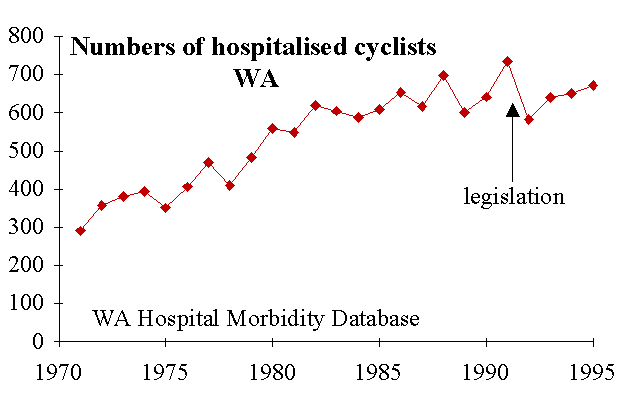
Figure 1. Absolute numbers of hospitalised cyclists (apart from those recorded as "unspecified road user")
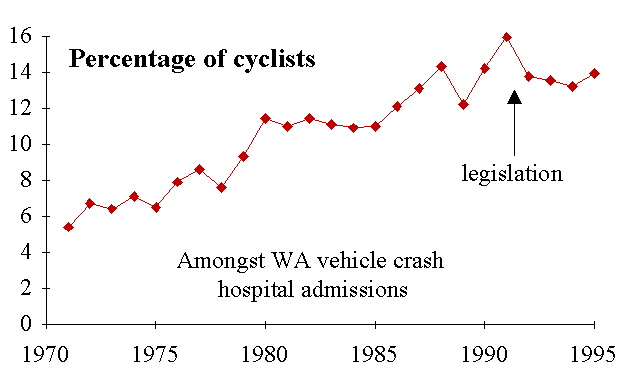
Data on Other Contemporaneous Road Safety Measures
Total road crash fatalities and injuries in Australia fell sharply over the period of the introduction of the helmet legislation. Published opinion varies on the weighting given to different factors, but an economic recession and safety measures like speed cameras, drink-driving enforcement and publicity campaigns have all played a part. Pedestrian fatalities in Victoria fell from 159 in 1989 to 93 in 1990, the year of the helmet law. Driver fatalities fell 32% that year as well. Road safety improvements of this magnitude at the same time as the helmet legislation make it hard to recognise and disentangle the effects of different factors. Indeed, using the same "one-parameter logic" as many of the initial helmet effectiveness reviews, it is possible to "show" in Figure 3. that helmet legislation has substantially reduced pedestrian fatalities in Victoria. But this is clearly impossible. Failure to recognise external factors such as other road safety and usage changes has devalued many Australian evaluations of helmet effectiveness.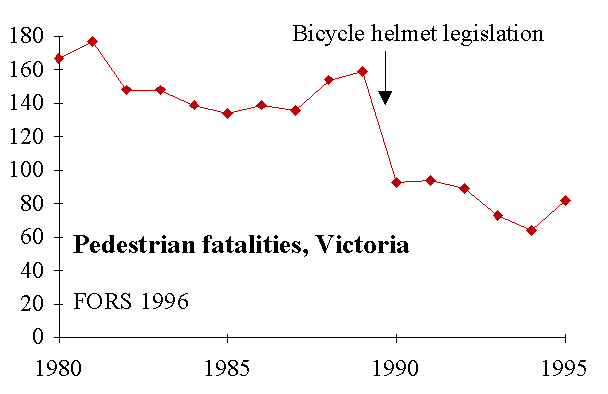
Figure 3: Does helmet legislation reduce pedestrian fatalities ?? The hazards of attributing changes only to one specific factor are illustrated.
Graphical and statistical comparisons with other data sets can be useful for recognising common trends and discrepancies, as shown in Fig 4.
Head Injuries
A bicycle helmet offers protection only to a very limited part of the body so only some injuries can be prevented or minimised by helmet wearing. One parameter which should show the most clear effect of helmet wearing rates is the ratio of head injuries (intracranial (brain), scalp and skull injuries) to other injuries not preventable by helmet wearing.Western Australia
The WA data on head injuries to cyclists are compiled from all 18 injury fields, but show similar trends to those from only the primary diagnosis field (Legge and Hendrie, 1996). They show a long-term trend of reduction in the proportion of head injuries to total injuries amongst hospitalised cyclists (Fig 5). However no significant effect of the legislation can be observed. This is the most convincing evidence that helmet legislation has not worked.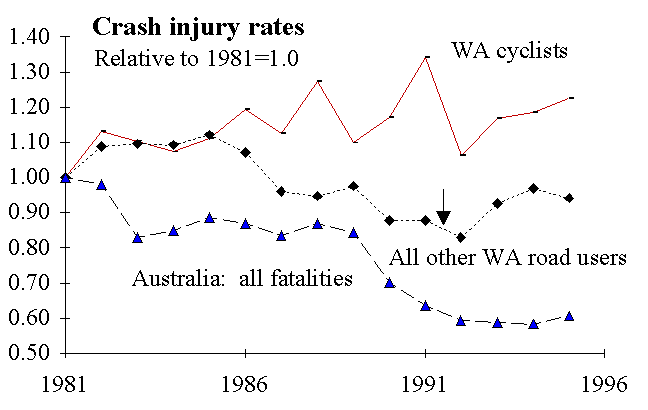
Figure 4. Comparison with changes from 1981 rates for WA cyclist hospital admissions, admissions of all other WA vehicle users, and total Australian road crash fatalities. 1992 legislation is arrowed.
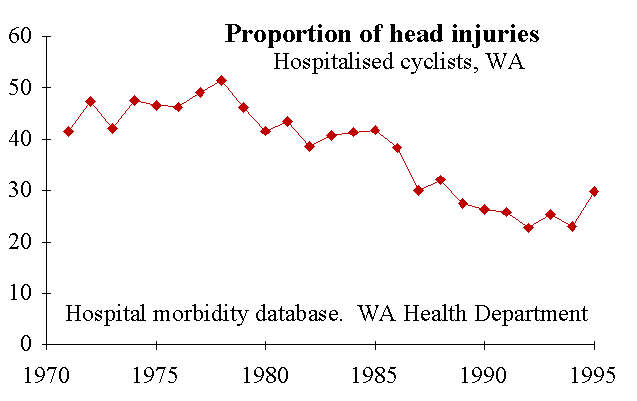
Figure 5. Percentage of head injuries amongst hospitalised cyclists in WA. It is not possible to discern from the graph the year of introduction of the legislation in WA (1-Jan-1992)
Victoria
Cameron et al (1994) fitted a logistic regression to the pre-law data and extrapolated it beyond the helmet law introduction. Post-law, the only significant change from the regression line was the 1992/93 point which lies below their 95% confidence limits. It is likely that changes in reporting rates, hospital procedures or some other factor can account for this discrepancy in an otherwise relatively smooth trend (Fig 6).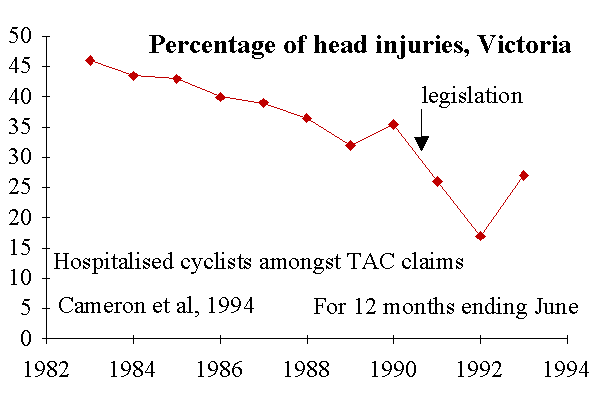 Figure 6. Percentage of head injuries to other injuries in TAC hospital admissions in Victoria.
Figure 6. Percentage of head injuries to other injuries in TAC hospital admissions in Victoria.South Australia and Queensland
The absence of analogous long-term trend information from studies in SA (Marshall and White, 1994) (see Fig 7) and Qld (King and Fraine, 1994), make it hard to verify the published information claiming positive head injury reduction from the helmet legislation, particularly given the demonstrated head injury reduction rates over time shown in all data. D. Robinson (1996b) shows similarly that head injury rates in Queensland do not show any significant effect from the legislation.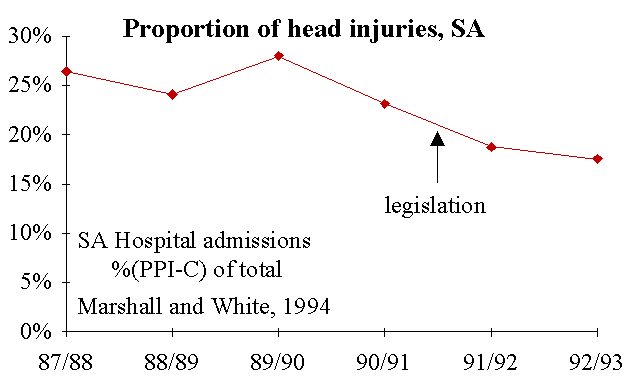
Fig 7. Percentage of hospitalised cyclists with head injuries, SA.
The SA data provide estimates of potentially preventible injuries (PPI), plus an allowance for the uncertainty of the treatment of suspected concussion (C) cases. Again, the data seem to show a long-term downwards trend and little or no significant effect of the helmet legislation.
The Qld data reported by King and Fraine (1994) are based on a small sample area, and provide little information on the existing trends in head injury reporting amongst hospital admissions. It would be wise to view the Qld data when it is presented as all-of-state data and with adequate time coverage before and after the introduction of the legislation.
Comparisons with Head-Injuries of Other Road Users
Comparisons with the proportions of head injury amongst other road users can be useful (D.Robinson, 1996a). In WA, the proportion of head injuries amongst pedestrians decreased during the mid 1980s, in line with that shown amongst hospitalised cyclists (Fig 8). The common trend in both probably reflect changes in hospital procedures. Hodge (1996) suggests that since the 1980s the use of CT scanning of head injuries of patients who attend emergency departments has resulted in a significant change in their diagnosis and management. People who attend with brief loss of consciousness are less likely to be admitted with a diagnosis of concussion and held in hospital for observation. It is no longer at all appropriate to attribute the long-term decline in head injury rates to increasing bicycle helmet wearing, unless it is proposed that this has also been protective of pedestrians at the same time. The divergence between WA pedestrian and cyclist rates in 1991 (before the legislation) is so far unexplained, and should receive further study. It may just be random variation.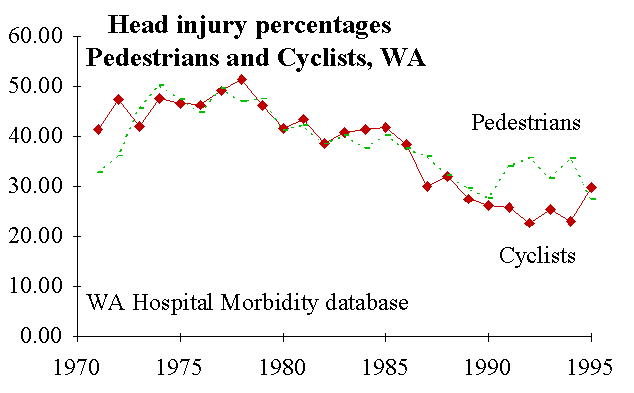 Fig 8. Analogous head injury percentage plots for both hospitalised cyclists and pedestrians in WA.
Fig 8. Analogous head injury percentage plots for both hospitalised cyclists and pedestrians in WA.Costs of Helmet Legislation
WA's helmet legislation has diverted resources from preventing bicycle crashes into increasing helmet wearing rates. For instance, about 50% of the WA Police Bicycle Safety Section's time is devoted to enforcing the helmet law. At the same time, about 80% of cyclists on the road at night are riding without lights, with very little chance of getting apprehended. There is a very strong case that enforcement should be directed to crash prevention measures. While helmet legislation has been introduced, many residential streets have been made far less safe for cyclists by uncontrolled traffic-management which discounts our needs. This has significantly increased the risk of bicycle crashes by introducing squeeze-points recognised as hazardous in the Geelong Bikeplan in 1977. Reduction of known generic hazards for cyclists is a recognised crash prevention countermeasure, however very little has been done, and many more hazards are being created than rectified.Apart from the helmet legislation, Federal, state and local governments have very largely ignored and discounted bicycle safety. By any parameter; either per user, per trip, per crash hospitalisation or per km, bicycle transport and safety is grossly under-resourced. In WA, many cyclists regard Bikewest as a largely powerless organisation, frequently ignored and over-ruled by other road and planning authorities. Commitments to provision of facilities for bicycle transport have not been fulfilled, while cyclists still get tickets for not wearing helmets. Resources should be devoted to prosecuting traffic engineers who endanger cyclists with poor road and path design and motorists who speed rather than cyclists who fail to wear helmets.
The helmet legislation has discouraged people from using bicycle transport. This has decreased community fitness levels, increased risks of serious diseases due to exercise deficit, and hence probably increased community health costs (Roberts et al, 1995). It is likely that these disbenefits are far more significant than any possible injury prevention benefit from helmet legislation.
Future Study
A detailed overall review of Australia's helmet legislation and its effectiveness should be carried out using all available data from all states. In particular, it is crucial that reliable hospital admission data be used, rather than incomplete surrogates like police reported-crash data and injury compensation scheme claims. It is requested that other states follow the invaluable lead of the WA Health Department in collecting data on road crash hospital admissions and making it readily available to researchers .It is also crucial that a nationwide database of hospitalised road crash victims, including bicyclists, be established. Apart from aiding road safety policy, this would help to overcome the very serious misallocation of road safety funding which arises from the use of police "reported crash" data to allocate "Black-Spot" funding and other resources within road authorities. The Federal Office of Road Safety was publishing nationwide hospital admission data from the National Injury Surveillance Unit for 1990, and 1991 (FORS, 1993, 1995). Unfortunately, FORS has discontinued publication of this valuable comparison between the Police "estimates" and the actual hospitalisation figures. It is vital that all states make hospital admission data available in the time frame that is needed for road safety policy.
Should Others Introduce Helmet Legislation?
Any countries or jurisdictions considering the introduction of compulsory helmet wearing laws should look very closely at the available data to see if it still supports such a move in light of the ambiguous Australian experience. It is essential that reliable evaluation methodologies be recognised, and the common shortcomings of both databases and interpretation which bedevilled the early Australian evaluations be avoided.Resources devoted, on the European model, to improving facilities for cyclists and to reducing urban speed limits are likely to be far more cost-effective than the introduction of helmet legislation. These measures must be considered as a valid alternative to helmet legislation or as a vital and integral part of such legislation.
It is crucial that a good and extensive data base of regional or national hospital admissions, and if possible hospital casualty department treatments be assembled for the decade or so preceding the legislation. This is needed to allow a reliable comparison with data collected after the introduction of any legislation.
Conclusion
It is fair to say that, so far, there is no convincing evidence that Australian helmet legislation has reduced the risk of head injury in bicycle crashes. It is not clear why the legislation has not been more effective.Acknowledgments I would like to acknowledge the foresight of the WA Health Department in collecting its invaluable Hospital Morbidity data set; the regular cooperation of Peter Somerford; encouragement, assistance and provision of WA data from Delia Hendrie and Matthew Legge of Roadwatch; and useful suggestions from Dorothy Robinson and Ian Roberts.
References
Brooks, B.H, and O'Neill, M, (1988). "Bicycle hospitalisations, WA, 1981-1987", Health Statistics Unit, Health Department of WA.Cameron, M., Newstead, S., Vulcan, P., and Finch, C. (1994), "Effects of the compulsory bicycle helmet wearing law in Victoria during its first three years". Proc. ARRB Workshop on Pedestrian and Bicycle Safety, Melbourne.
DoT (1995). Metropolitan Transport Strategy, Department of Transport, WA
FORS (1993). "Road crashes resulting in hospitalisation, Australia, 1990". Federal Office of Road Safety, Canberra.
FORS (1995). "Road crashes resulting in hospitalisation, Australia, 1991". Federal Office of Road Safety, Canberra. p 88.
FORS (1996) "Road fatalities Australia, 1995 statistical summary", Federal Office of Road Safety, 1996
Geelong Bikeplan (1977). Main report, Geelong Regional Commission.
Hendrie, D, and Ryan, G.A., 1994 "A 'best' estimate of the number of pedal cyclists injured in Western Australia: Some policy implications". Proc. 17th ARRB conference, Brisbane. Part 5, 253-268
Hillman, M. (1993a). "Cycle helmets; the case for and against". Policy Studies Institute, London.
Hillman, M. (1993b). "The case for and against promoting helmet wearing". Proc. 21st Summer meeting, PTRC European Transport, Highways and Planning; Traffic Management and Road Safety. 13-17th September, 1993. University of Manchester.
Hodge, J (1996). Emergency Department, Fremantle Hospital. Personal communication 10th October.
King, M. and Fraine, G. (1994) "Bicycle Helmet legislation and enforcement in Queensland 1991-1993. Effects on helmet wearing and crashes". Proc. ARRB Workshop on Pedestrian and Bicyclist Safety and Travel, Melbourne.
Legge, M, and Hendrie, D., (1996). "Road Injury Database; Subset of WA Health Department Hospital Morbidity Database". Unpublished. Road Accident Prevention Unit, University of Western Australia.
Lugg, M, (1982) "Hospital morbidity statistics, pedal cycle accidents, 1971-1980". Statistics Branch, Public Health Department of WA.
Marshall, J., and White, M., (1994). "Evaluation of the compulsory helmet wearing legislation for bicyclists in South Australia". Office of Road Safety report series 8/94
O'Neill, M., (1991) "Bicycle hospitalisations, WA, 1988-1990", Health Services Statistics Unit, Health Department of WA.
Roberts, I, Owen, H., Lumb, P, MacDougall, C. (1995) "Pedalling health. Health benefits of a modal transport shift". Adelaide.
Robinson, B.W. (1992), "Bicycle usage and safety in Australia. An estimate of current levels and trends". Proc. AusBike 92, 97-99. Melbourne
Robinson, B.W. (1994). "Bicycle usage and safety in Australia; a 1994 review". Bicycle Federation of Australia
Robinson, D.L. (1996a). "Head injuries and bicycle helmet laws". Accident analysis and prevention. 28/4 463-475
Robinson, D.L, (1996b) "Head injuries, helmet laws and health". Proc. Velo Australis, Perth (this volume)